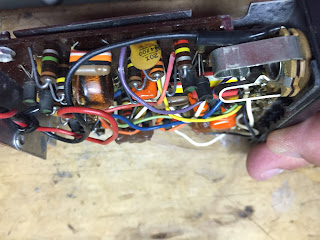The octave divider, which was part of the Vox guitar amplifier line manufactured by the Thomas organ company, allowed a trumpet player to lower the pitch of his/her instrument by one or two octaves. It was called the Octavoice, and you can read more about it here:
http://www.voxshowroom.com/us/amp/octavoice.html
To use the Octavoice, the trumpet player drilled a hole in the mouthpiece, and screwed in an adapter that allowed the Octavoice's transducer fitting to be attached to the mouthpiece. Since I'm a trombonist, this picture shows the fitting on a trombone mouthpiece.
And when the transducer is attached to the mouthpiece, it looks like this.
This device was produced in the late 1960s or early 1970s, so there is no digital signal processing going on. Inside the box are a bunch of transistors, resistors, capacitors, and inductors - not even any IC op amds. I'm a little stymied on how this box could produce an octave shift down, but I am a computer engineer, not an electrical engineer. Here are some photos of the inside of the box.
Whether or not I understand how it works, it does work. I used it to record the "tuba" track for an entry in the contest to be the song on the flexi-disc included with the Billy And The Boingers Bootleg collection of Bloom County comics by Berkeley Breathed. We didn't win, since we weren't so heavy metal, but I still do sort of like the song we made.
So, for DBaylies: if anyone can offer suggestions on how to build something similar to how build a mouthpiece-attached transducer, post here. The goal is to get an audio signal into the input of an analog-digital converter for processing in the digital domain.




